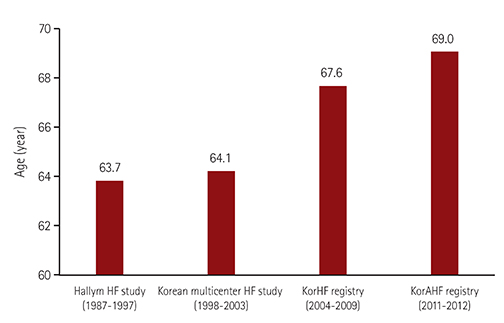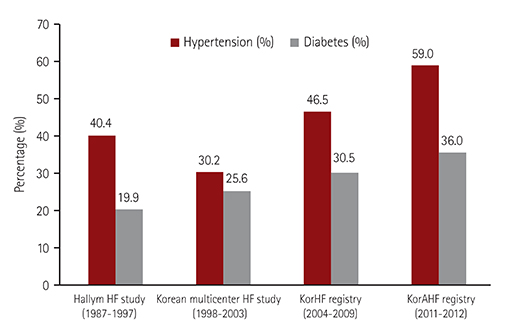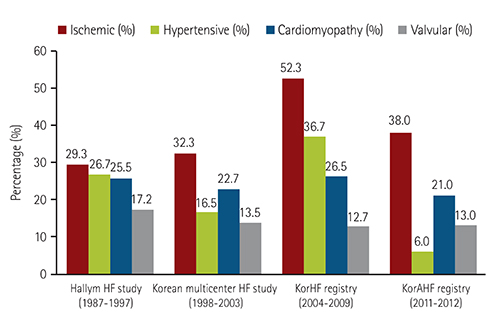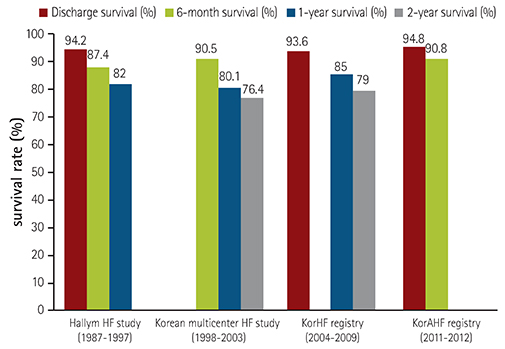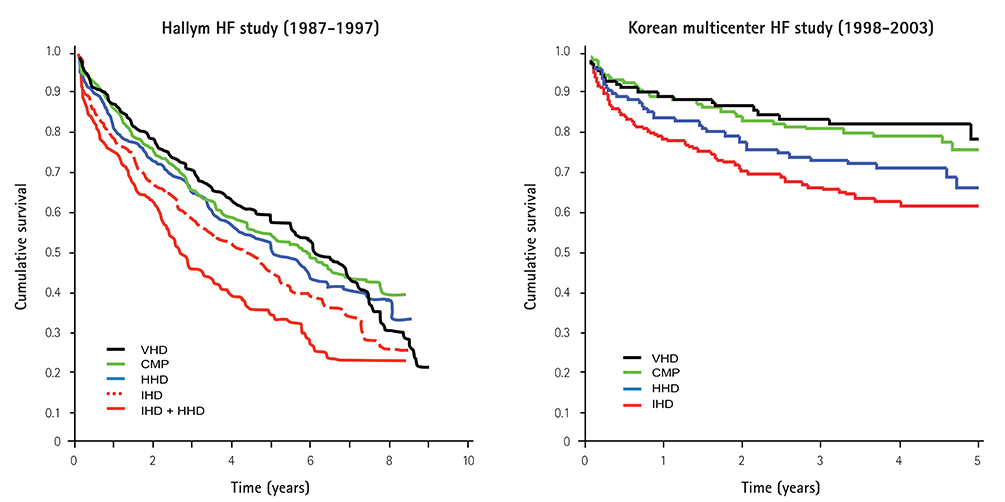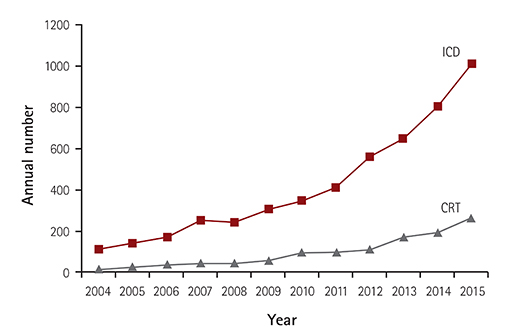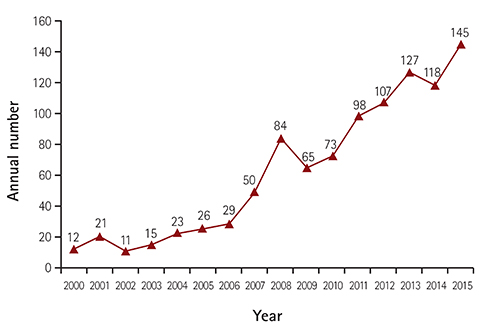Temporal Trends of Hospitalized Patients with Heart Failure in Korea
- Affiliations
-
- 1Division of Cardiology, Dongtan Sacred Heart Hospital, Hallym University College of Medicine, Hwaseong, Korea. hansw29@hallym.or.kr
- KMID: 2365275
- DOI: http://doi.org/10.4070/kcj.2016.0429
Abstract
- Heart failure (HF) is an important cardiovascular disease because of its increasing prevalence, significant morbidity, high mortality and rapidly expanding health care costs. The number of HF patients is increasing worldwide and Korea is no exception. Temporal trends of four representative Korean hospitalized HF registries-the Hallym HF study, the Korean Multicenter HF study, the Korean Heart Failure (KorHF) registry and the Korean Acute Heart Failure (KorAHF) registry showed mild survival improvement reflecting overall HF patient care development in Korea despite the increased severity of enrolled patients with higher incidence of multiple comorbidities. Moreover, device therapies such as implantable cardioverter defibrillator and cardiac resynchronization therapy and definitive treatment such as heart transplantation have been increasing in Korea as well. To prevent HF burden increase, it is essential to set up long term effective prevention strategies for better control of ischemic heart disease, hypertension and diabetes, which might be risk factors for HF development. Moreover, proper HF guidelines, performance measures, and performance improvement programs might be necessary to limit HF burden as well.
Keyword
MeSH Terms
Figure
Cited by 10 articles
-
Factors Associated with Low Awareness of Heart Failure in the General Population of Korea
Hack-Lyoung Kim, Mi-Hyang Jung, Jae Hyuk Choi, Sunki Lee, Min Gyu Kong, Jin Oh Na, Yang Hyun Cho, Kyoung-Im Cho, Dong-Ju Choi, Eung Ju Kim
Korean Circ J. 2020;50(7):586-595. doi: 10.4070/kcj.2019.0401.Cardiovascular Complications of Novel Anti-Cancer Immunotherapy: Old Problems from New Agents?
Woo-Baek Chung, Jong-Chan Youn, Ho-Joong Youn
Korean Circ J. 2020;50(9):743-753. doi: 10.4070/kcj.2020.0158.Trends in Cardiovascular Complications and Mortality among Patients with Diabetes in South Korea
Jung Hwan Park, Kyoung Hwa Ha, Bo Yeon Kim, Jae Hyuk Lee, Dae Jung Kim
Diabetes Metab J. 2021;45(1):120-124. doi: 10.4093/dmj.2020.0175.A New Era of Targeting Pathogenic Immune Mechanisms in Cardiovascular Disease
Myung-Soo Park, Jong-Chan Youn
Korean Circ J. 2018;48(10):944-946. doi: 10.4070/kcj.2018.0158.The Past, Present and Future of Cardiac Resynchronization Therapy
Thomas O'Brien, Myung-Soo Park, Jong-Chan Youn, Eugene S. Chung
Korean Circ J. 2019;49(5):384-399. doi: 10.4070/kcj.2019.0114.Increased Risk with Older Donor Age and More Frequent Pre-transplant ECMO: the Second Official KOTRY Report
Jong-Chan Youn, In-Cheol Kim, Nam-Hee Park, Hyungseop Kim
Korean Circ J. 2019;49(8):738-741. doi: 10.4070/kcj.2019.0117.Tachycardia induced Cardiomyopathy
Do Young Kim, Sung Hea Kim, Kyu-Hyung Ryu
Korean Circ J. 2019;49(9):808-817. doi: 10.4070/kcj.2019.0199.Korea Heart Disease Fact Sheet 2020: Analysis of Nationwide Data
Hyeok-Hee Lee, So Mi Jemma Cho, Hokyou Lee, Jongmin Baek, Jang-Ho Bae, Wook-Jin Chung, Hyeon Chang Kim
Korean Circ J. 2021;51(6):495-503. doi: 10.4070/kcj.2021.0097.Acute Heart Failure and Its Management
Seonghoon Choi
J Neurocrit Care. 2018;11(1):13-22. doi: 10.18700/jnc.180047.Update on the Pharmacotherapy of Heart Failure with Reduced Ejection Fraction
Eui-Soon Kim, Jong-Chan Youn, Sang Hong Baek
Cardiovasc Prev Pharmacother. 2020;2(4):113-133. doi: 10.36011/cpp.2020.2.e17.
Reference
-
1. Ponikowski P, Voors AA, Anker SD, et al. 2016 ESC Guidelines for the diagnosis and treatment of acute and chronic heart failure: The Task Force for the diagnosis and treatment of acute and chronic heart failure of the European Society of Cardiology (ESC) Developed with the special contribution of the Heart Failure Association (HFA) of the ESC. Eur Heart J. 2016; 37:2129–2200.2. Stewart S, MacIntyre K, Hole DJ, Capewell S, McMurray JJ. More ‘malignant’ than cancer? Five-year survival following a first admission for heart failure. Eur J Heart Fail. 2001; 3:315–322.3. Ziaeian B, Fonarow GC. Epidemiology and aetiology of heart failure. Nat Rev Cardiol. 2016; 13:368–378.4. Askoxylakis V, Thieke C, Pleger ST, et al. Long-term survival of cancer patients compared to heart failure and stroke: a systematic review. BMC Cancer. 2010; 10:105.5. Writing Group Members. Mozaffarian D, Benjamin EJ, et al. Heart disease and stroke statistics-2016 update: a report from the American Heart Association. Circulation. 2016; 133:e38–e360.6. Heidenreich PA, Albert NM, Allen LA, et al. Forecasting the impact of heart failure in the United States: a policy statement from the American Heart Association. Circ Heart Fail. 2013; 6:606–619.7. Okura Y, Ramadan MM, Ohno Y, et al. Impending epidemic: future projection of heart failure in Japan to the year 2055. Circ J. 2008; 72:489–491.8. Lee JH, Lim NK, Cho MC, Park HY. Epidemiology of Heart Failure in Korea: Present and Future. Korean Circ J. 2016; 46:658–664.9. Park JJ, Choi DJ. Heart failure epidemic: an expected phenomenon. Korean Circ J. 2016; 46:610–612.10. Fang J, Mensah GA, Croft JB, Keenan NL. Heart failure-related hospitalization in the U.S., 1979 to 2004. J Am Coll Cardiol. 2008; 52:428–434.11. Teng TH, Finn J, Hobbs M, Hung J. Heart failure: incidence, case fatality, and hospitalization rates in Western Australia between 1990 and 2005. Circ Heart Fail. 2010; 3:236–243.12. Filippatos G, Farmakis D, Bistola V, et al. Temporal trends in epidemiology, clinical presentation and management of acute heart failure: results from the Greek cohorts of the Acute Heart Failure Global Registry of Standard Treatment and the European Society of Cardiology-Heart Failure pilot survey. Eur Heart J Acute Cardiovasc Care. 2014; [Epub ahead of print]. DOI: 10.1177/2048872614527012.13. Agarwal SK, Wruck L, Quibrera M, et al. Temporal Trends in Hospitalization for Acute Decompensated Heart Failure in the United States, 1998-2011. Am J Epidemiol. 2016; 183:462–470.14. Kang SM, Cho MC. Prognostic Factors in Hospitalization for Heart Failure in Asia. Heart Fail Clin. 2015; 11:543–550.15. Lee Y. Chinical characteristics of korean patients with congestive heart failure. Korean J Med. 1998; 55:446–452.16. Han SW, Ryu KH, Chae SC, et al. Multicenter analysis of clinical characteristics and prognostic factors of patients with congestive heart failure in Korea. Korean Circ J. 2005; 35:357–361.17. Choi DJ, Han S, Jeon ES, et al. Characteristics, outcomes and predictors of long-term mortality for patients hospitalized for acute heart failure: a report from the korean heart failure registry. Korean Circ J. 2011; 41:363–371.18. Lee SE, Cho HJ, Lee HY, et al. A multicentre cohort study of acute heart failure syndromes in Korea: rationale, design, and interim observations of the Korean Acute Heart Failure (KorAHF) registry. Eur J Heart Fail. 2014; 16:700–708.19. Hong SJ, Oh J, Kang SM, et al. Clinical implication of right bundle branch block in hospitalized patients with acute heart failure: data from the Korean Heart Failure (KorHF) Registry. Int J Cardiol. 2012; 157:416–418.20. Lee SE, Choi DJ, Yoon CH, et al. Improvement of hyponatraemia during hospitalisation for acute heart failure is not associated with improvement of prognosis: an analysis from the Korean Heart Failure (KorHF) registry. Heart. 2012; 98:1798–1804.21. Yoon CH, Youn TJ, Ahn S, et al. Low serum total cholesterol level is a surrogate marker, but not a risk factor, for poor outcome in patients hospitalized with acute heart failure: a report from the Korean Heart Failure Registry. J Card Fail. 2012; 18:194–201.22. Youn YJ, Yoo BS, Lee JW, et al. Treatment performance measures affect clinical outcomes in patients with acute systolic heart failure: report from the Korean Heart Failure Registry. Circ J. 2012; 76:1151–1158.23. Oh J, Kang SM, Hong N, et al. Hemoconcentration is a good prognostic predictor for clinical outcomes in acute heart failure: data from the Korean Heart Failure (KorHF) Registry. Int J Cardiol. 2013; 168:4739–4743.24. Oh J, Kang SM, Hong N, et al. The CKD-EPI is more accurate in clinical outcome prediction than MDRD equation in acute heart failure: data from the Korean Heart Failure (KorHF) Registry. Int J Cardiol. 2013; 167:1084–1087.25. Park HS, Kim H, Park JH, et al. QRS prolongation in the prediction of clinical cardiac events in patients with acute heart failure: analysis of data from the Korean Acute Heart Failure Registry. Cardiology. 2013; 125:96–103.26. Park SJ, On YK, Byeon K, et al. Short- and long-term outcomes depending on electrical dyssynchrony markers in patients presenting with acute heart failure: clinical implication of the first-degree atrioventricular block and QRS prolongation from the Korean Heart Failure registry. Am Heart J. 2013; 165:57–64.e2.27. Park JJ, Choi DJ, Yoon CH, et al. Prognostic value of C-reactive protein as an inflammatory and N-terminal probrain natriuretic peptide as a neurohumoral marker in acute heart failure (from the Korean Heart Failure registry). Am J Cardiol. 2014; 113:511–517.28. Kang SH, Park JJ, Choi DJ, et al. Prognostic value of NT-proBNP in heart failure with preserved versus reduced EF. Heart. 2015; 101:1881–1888.29. Oh J, Kang SM, Song MK, et al. Clinical benefit of spironolactone in patients with acute decompensated heart failure and severe renal dysfunction: Data from the Korean Heart Failure Registry. Am Heart J. 2015; 169:713–720.e3.30. Park JJ, Choi DJ, Yoon CH, et al. The prognostic value of arterial blood gas analysis in high-risk acute heart failure patients: an analysis of the Korean Heart Failure (KorHF) registry. Eur J Heart Fail. 2015; 17:601–611.31. Ryu KH, Han SW. Clinical Characterisrics and prognositic factors of patients with congestive heart failure in Korea (epidemiology of congestive heart failure in Korea). J Korean Soc Hypertens. 2002; 8:38–47.32. Youn JC, Seo SM, Lee HS, et al. Trends in hospitalized acute myocardial infarction patients with heart failure in Korea at 1998 and 2008. J Korean Med Sci. 2014; 29:544–549.33. Sato N. Epidemiology of Heart Failure in Asia. Heart Fail Clin. 2015; 11:573–579.34. Bae MH, Chae SC. Hyponatremia in acute heart failure: a marker of poor condition or a mediator of poor outcome? Korean J Intern Med. 2015; 30:450–452.35. Yoo BS, Park JJ, Choi DJ, et al. Prognostic value of hyponatremia in heart failure patients: an analysis of the Clinical Characteristics and Outcomes in the Relation with Serum Sodium Level in Asian Patients Hospitalized for Heart Failure (COAST) study. Korean J Intern Med. 2015; 30:460–470.36. Shin TG, Choi JH, Jo IJ, et al. Extracorporeal cardiopulmonary resuscitation in patients with inhospital cardiac arrest: a comparison with conventional cardiopulmonary resuscitation. Crit Care Med. 2011; 39:1–7.37. Korean Network for Organ Sharing (KONOS). Official Web site of the KONOS [Internet]. c2016. cited 2016 July 1. https://www.konos.go.kr/konosis/index.jsp.38. Krittayaphong R, Ariyachaipanich A. Heart Transplant in Asia. Heart Fail Clin. 2015; 11:563–572.
- Full Text Links
- Actions
-
Cited
- CITED
-
- Close
- Share
- Similar articles
-
- Current status of heart failure: global and Korea
- Key Role of the Korean Society of Heart Failure: Moving Towards a Global and Individualized Approach
- Thirty-six Year Trends in Mortality from Diseases of Circulatory System in Korea
- The Korean Society of Heart Failure: Breaking Barriers, Bridging Solutions Together!
- Temporal Trends of Cardiac Implantable Electronic Device Implantations: a Nationwide Population-based Study

